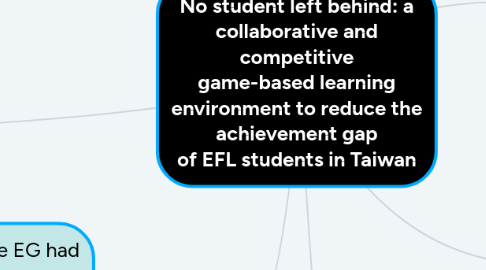
1. Literature Review
1.1. Collaboration, competition, and cooperation in game-base learning
1.2. Mobile technologies and one-on-one digital classroom environment
2. Methodology
2.1. Instrument
2.1.1. 1. Classroom Experiment
2.1.2. 2. Questionnaire
2.1.3. 3. Interview
2.2. The Sample
2.2.1. 30 students from sixth grade at NS elementary school (15 boys and 15 girls, aged 11–12 years)
2.3. The Research process in Action and Reflection
2.3.1. Preparation Stages
2.3.2. Action Stages
2.3.2.1. Collaborative preaparation work
2.3.2.2. Collaborative Learning in the Classroom
2.3.2.3. Group Processing
2.3.3. Reflective and Adjusment
3. Discussion
3.1. The low-achievement students in the EG had a better learning performance and a more positive attitude than those in the CG
3.2. The potential effects of our approach on the low-achievement students
4. This is an action Research done by Hui-Chun Hunga, Shelley Shwu-Ching Youngb and Chiu-Pin Linc. Published by Technology, Pedagogy and Education, 2015.
5. Introduction
5.1. Current Classroom Condition
5.1.1. Considerable concern has arisen over the achievement gap between affluent and disadvantaged elementary students
5.1.2. The achievement gap that separates disadvantaged children and their peers is believed to be one of the most crucial factors hindering the implementation of EFL teaching.
5.2. Expectation
5.2.1. a collaborative and competitive game-based environment integrated into formal English learning to reduce the achievement gap for disadvantaged students
6. Development of the learning environment
6.1. Crossword Fan-Tan Game
6.2. Wireless Crossword Fan-Tan Game (WiCFG) system
7. Results
7.1. Learning performance of the EG and CG
7.1.1. Compared the learning performance of high-achievement and low-achievement students
7.1.2. The low-achievement students in the EG had a better learning performance than those in the CG
7.2. Students’ perceptions and attitudes toward endurability engagement, and expectations
7.2.1. The students had positive perceptions and attitudes toward endurability, engagement, and expectations
7.2.2. The students using WiCFGhad a positive perception of spending time in participating in the learning activity over and over again
7.3. Interview responses
7.3.1. The high-achievement students expressed their interests in the innovative approach
7.3.2. The low-achievment students expressed their interests in the innovative approach
7.3.3. The teacher expressed positive feedback to the innovative approach
7.4. The group interaction observation
7.4.1. Students in the EG were more active in offering positions, making arguments, responses, and showing support

